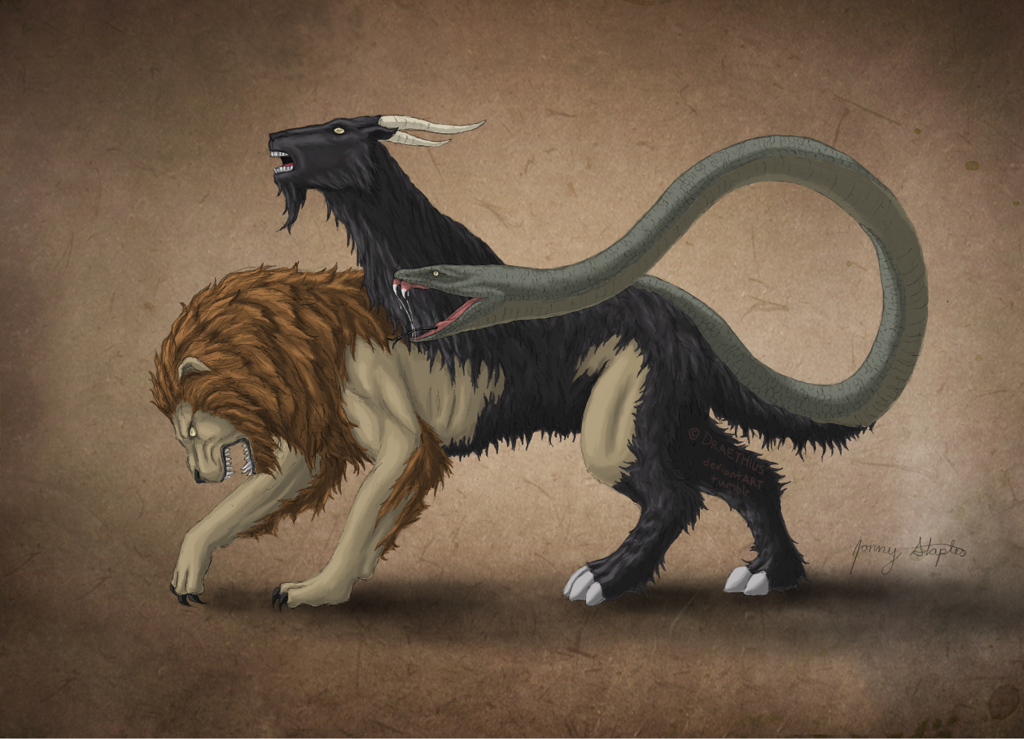
They use it as a warning of impending doom on one’s life if they don’t make changes that befit the gods. It is like an ambassador for their messages. Since it is a mythical creature, the chimera is the embodiment of the celestial world. According to the belief, she lived in Lycia (Likya in modern Turkey) in. Chimera’s head was that of a lioness while she had a goat’s head on her back and a snake’s head at the tip of her tail. Moreover, it depicts the most horrendous type of symbols that one should think twice about having. Chimera (Chimaera or Khimaira) is a mythical creature which is believed to be formed of three different animals a lioness, a goat and a snake. The chimera as an animal spirit is not all fun and games. The deceit of the snake is the reason leading to the kicking of humans out of the garden. It lied to a woman to eat from the forbidden fruit from the middle of the Garden of Eden. The snake also, as per the Christian beliefs, was the one that made the two humans on earth abandon their beautiful home. This is because it spends most of its lifetime slithering on the planet. Also, the snake is one of the animals that have great sync to the mother earth. Also, the snake people are sleek, stealthy, strange, and sneaky. The protruding ears in the Chimera’s depiction are the artist’s effort to reveal the awe-inspiring beast as a female Lioness despite having Lion-like attributes.
Chimera animal full#
The serpent spirit animal signifies the unpredictability of the snake people. Chimera is a fire-breathing beast featuring the head of a lion with a full mane, but with ears protruding from the wild mane in many sculptures. Moreover, the wild goats like the angora goat have proven to be quite brave and defensive of their family members. They are quite understanding and can be the voice of reason most of the time. Moreover, the goat people love the notion of being a bother, but they also have a soft side. They also have the most excellent care for their kids. They have been the source of food for men for many years.

However, another look at the goat, and one will realize the benefits of the goats. The goat, therefore, lacks the best qualities. We hope that our results, in revealing the conceptual and argumentative structure of the debate and highlighting some its most notable tendencies and prominent positions, will facilitate continued discussion and provide a basis for the development of relevant policy and legislation.Ĭhimera research Ethics Human-animal chimeras Systematic review.The chimera goat spirit animal in real life is the significance of ravenous, stubbornness, and randomness.

A significant proportion of identified passages (46%) fell under Category C. The reasons against conducting chimera research fell into four further categories: reasons concerning the creation of a chimera (Category A), its treatment (Category B), reasons referring to metaphysical or social issues resulting from its existence (Category C) and to potential downstream effects of chimera research (Category D). 15% of the retrieved passages contained reasons in favor of conducting chimera research (Category P), while 85% of the passages contained reasons against it. We classified these reasons into five categories and, within these, identified 12 broad and 31 narrow reason types. Within these articles, we found 464 passages containing reasons for and against conducting human-animal chimera research. Papers containing ethical reasons were analyzed, and the reasons were coded according to whether they were endorsed, mentioned or rejected.įour hundred thirty-one articles were retrieved by our search, and 88 were ultimately included and analyzed. We conducted a systematic review of the ethical literature concerning human-animal chimeras based on the research question: "What ethical reasons have been given for or against conducting human-animal chimera research, and how have these reasons been treated in the ongoing debate?" Our search extends until the end of the year 2017, including MEDLINE, Embase, PhilPapers and EthxWeb databases, restricted to peer-reviewed journal publications in English. This paper attempts to remedy this by providing a systematic review of ethical reasons in academic publications on human-animal chimera research. Due to the many dimensions of potential ethical conflict involved in this type of research, and the wide variety of research projects under discussion, it is difficult to obtain an overview of the ethical debate. The burgeoning field of biomedical research involving the mixture of human and animal materials has attracted significant ethical controversy.


 0 kommentar(er)
0 kommentar(er)
